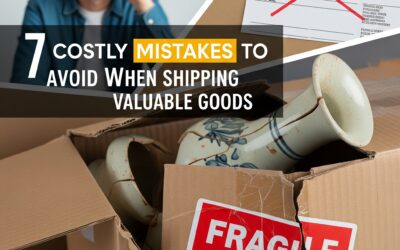Getting products to customers efficiently and cost-effectively is essential for small business success. Navigating the complex world of shipping and logistics can be challenging. That’s because small businesses have limited resources.
Multiple factors impact the effectiveness of your shipping strategy. Also, understanding shipping options helps, and integrating shipping solutions aids operations.
A solid strategy lets you focus your energy on growing your small business. Whether you are a small business owner with an online store, retail or wholesale, optimized shipping can help.
Read on to learn about considerations and options small businesses have to improve Canadian and global shipping.
Choosing the Right Shipping Method for Small Businesses
Shipping products is a crucial part of running small businesses in the ecommerce or retail sector that require frequent, affordable shipping. Choosing the right international shipping carrier and method can impact your customers’ experience, operational costs, and ultimately, your client base. When shipping packages across Canada as a small business, you have a few main options for shipping services. These include Canada Post, UPS, and FedEx.
Canada Post offers distinct advantages with its affordable and widespread domestic coverage, reaching places UPS and FedEx can’t touch. Their deep roots in Canadian neighbourhoods make them a sensible default.
However, for time-sensitive deliveries or larger shipments, the larger networks and tracking technologies of integrated carriers like UPS and FedEx can provide more accuracy and speed—though typically at a higher cost.
Each carrier has its strengths. Therefore, you should choose between the vast coverage and efficiency of Canada Post, UPS’s optimized reliability, or FedEx’s extensive experience. Whichever your choice, shipping supplies as a Canadian small business ultimately comes down to balancing coverage, cost, and the priorities of your customers.
Factors to Consider When Choosing a Shipping Partner
Here are the important things to consider when choosing a shipping company for your small business:
- Reliability: You want a company with a great track record for on-time deliveries with low damage and lost package rates.
- Shipment tracking: Make sure they provide transparency during the shipping process.
- Delivery speeds: See what speed options they offer and the average time in transit for each option.
- Pricing: Compare pricing for their different services like ground shipping, express, and international.
- Customer service: Make sure the shipping company has responsive customer support available.
- Insurance options: See what insurance options they provide in case packages get lost or damaged during shipping.
- Packaging supplies: Some shipping companies provide the boxes, envelopes, tapes, and other packing materials you’ll need.
- Technology integrations: Integrations with your store’s platform or warehouse software can help automate tasks and improve efficiency.
Packaging and Labelling for Efficient Shipping
Your packaging says everything about you and your brand before customers even see your products. Packaging well ensures safe delivery and happy customers—the lifeblood of any business.
Here are the best tips for smart packaging that will maximize your shipping success:
- Use tough boxes: For extended shipping times or rough conditions you need shipping materials that can help deliver the packages safely. A sturdy corrugated cardboard is ideal. For fragile items, double-box them with space between the layers. Fill any gaps with cushioning material to prevent items from moving and breaking in transit.
- Secure everything shut: Seal all flaps tightly with packing tape, applying ‘X’ shapes across each one for reinforcement. Are items left loose inside? Pop them in a plastic bag first.
- Pad the insides well: Fill the entire empty space in the box with cushioning like air pillows, bubble wrap, foam peanuts, or tissue paper. This will stop your goods from getting jostled around and damaged during shipping.
- Label clearly and completely: Include your company name and full address on multiple sides of the box. Pre-printed shipping labels make the process faster. The more info, the better!
- Warn when needed: Liquids, perishables, hazards—anything requiring special care gets labelled appropriately. Follow all relevant regulations to keep everyone safe.
- Don’t go overboard: Only use enough packing material to protect your items well. Excess packaging wastes money and natural resources. Do more with less.
- Reuse and recycle smartly: Consider reusing boxes, bubbles, and air pillows before buying new ones. Things that can’t be reused get recycled instead of being tossed.
Your packaging makes a lasting first impression, so do it right! Take the time to package items securely, apply the proper labels, and fill out complete shipping info. Doing so sets up your products and business for shipping success. Smart packaging is a powerful yet often overlooked marketing tool. Make the most of it!
Managing Shipping Costs and Negotiating Rates
For small businesses, shipping costs can take a large portion of profits. You can get the lowest rates by negotiating effectively.
Pay attention to managing shipping expenses regularly. Realistically evaluate your shipping needs. Set a shipping budget that allows for demand changes. This avoids stockouts and rushed orders. Also, compare standard versus expedited options.
Research carriers that serve your market. Compare the costs of Canada Post, Purolator, FedEx, and UPS. Ask for promo rates and discounts based on your needs. Select a partner that meets your reliability, pickup, delivery, and tracking needs. The more you ship with one carrier, the higher discounts you get.
Build the relationship. Work with an account manager. Discuss goals and volumes honestly. Request cost reviews periodically. Look for bundled services that lower expenses. Optimize packaging to maximize density safely and quickly. Use shipping software to catch errors and track shipments efficiently. You can minimize costs over time to grow your business.
Shipping products as a small business can be hard but also rewarding. Navigating regulations, finding good rates, and ensuring on-time delivery are key challenges to overcome. The key is to see shipping as a chance—to expand your reach, impress customers, and build expertise that benefits you for years.
When your products arrive safely, ready to brighten a customer’s day, you’re reminded why you started—to make and share something of value. Small businesses, therefore, need to keep pursuing better shipping. Optimize every part of the process you can control. Work to lower costs.
Every package sent gets you closer to scaling and realizing your full vision. As you improve, more customers will come. Your business and what you create will have a greater positive impact.
Sign up free and with zero obligation to see how much you can save with ShipSimple.ca today.





